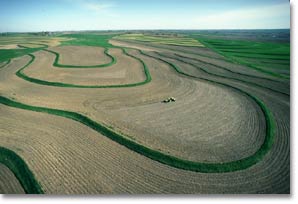
Photos used by permission from the USDA Online Photography Center.



For thousands of years people have used terraces to improve farming. In some mountainous regions of the world, steep slopes are grooved with terraces. Looking down from the side of a mountain, these terraces carve beautifully formed patterns into the already lush landscape. This stair-step pattern makes it possible for farmers to grow rice on the side of a mountain.

Rice Terraces, Batad, Banaue, The Philippines
Copyright: Photo © Reggie Thomson
In Iowa, gently rolling hills and flat lands allow over 90 percent of the state to be farmed. Iowa's varied and beautiful landscape is shaped by patterns best seen from an airplane. But the practice of contour farming with terraces and buffer strips doesn't just make the landscape beautiful. It also helps save the soil.

When contour farming is practiced, the rows of crops are planted around the side of a sloping hill instead of up and down the hill. The rows of crops actually help to slow the water down. Thus runoff from heavy rains that would otherwise run quickly down the slope, flows gently between the rows to grassy buffer strips. When the water reaches these grassy areas, it will not carry the soil with it because the grass helps hold the soil in place.
Most farmers are not thinking about an art project when they practice contour farming. But just as mountain terraces form beautiful and artistic shapes when seen from a distance, contour farming also creates interesting and artistic patterns.
Grant Wood, one of Iowa's most important artists, saw the Iowa landscape as art. In his famous painting of Stone City Grant Wood placed pasturelands, cornfields, and hay fields on the landscape to form a beautiful design. Of course, early contour farming, such as he portrayed in his art, didn't benefit from today's powerful machinery.
Using Stone City as a model, create your own version of the painting. Include terraces and buffer strips. Remember which direction crops should be planted on the side of a hill.
Share your "Conservation Conscious" painting of Stone City with your teacher and classmates.

Copyright © 2022 CampSilos | All Rights Reserved
National Standards | Silos & Smokestacks | Credits | Awards
Crafted by IFC Studios, a midwest Branding Agency.